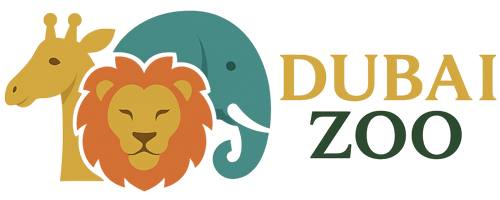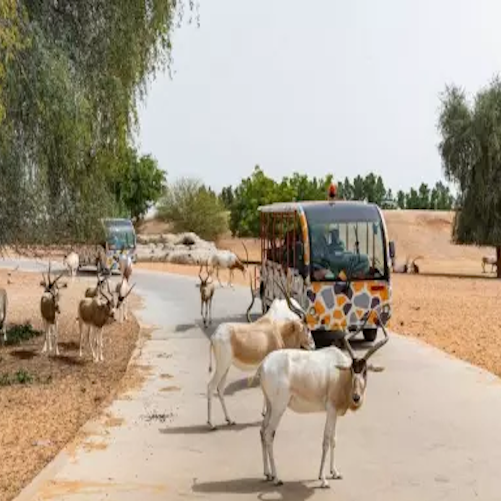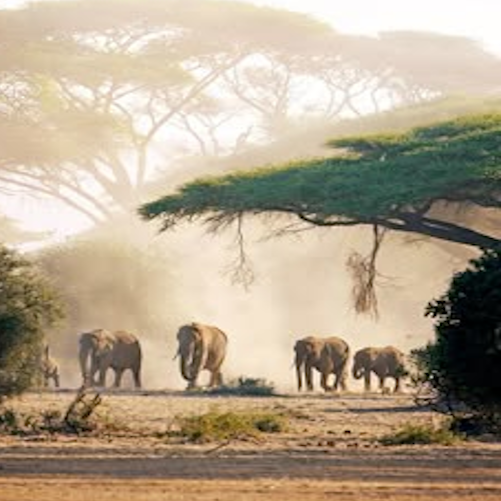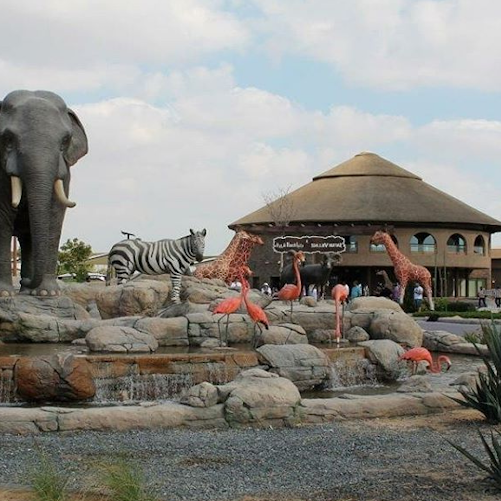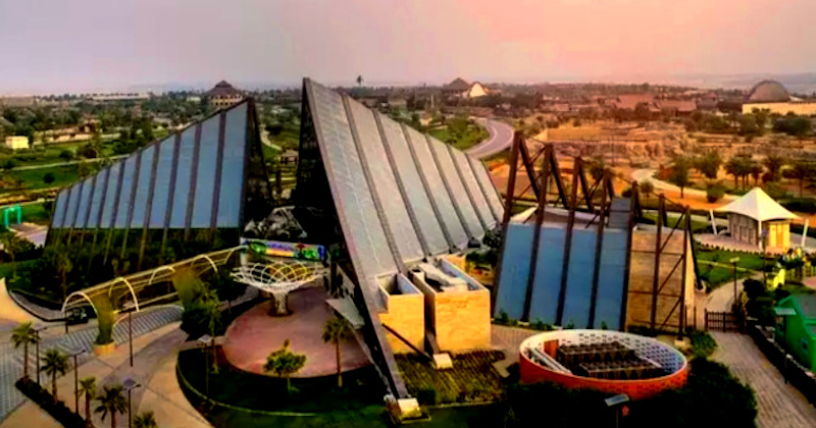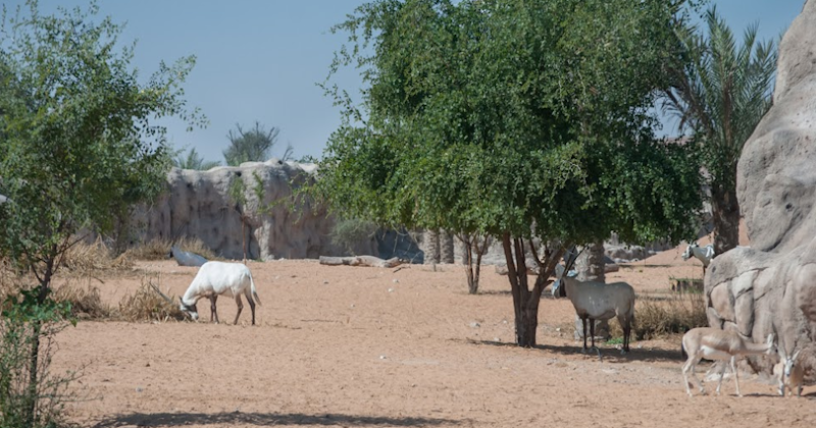Tickets
Tours
Reviews
A wonderful place to introduce your child to nature. I try to take a safari tour on all my trips. And here there are many animals in one place. In terms of size and number of animals, it is similar to the Berlin Zoo, only everything is done more technologically. And the interactive bus tour past elephants, hippos, and lions is very impressive. The park is divided into zones, with buses running between them, which makes it much easier to see everything.

Jonathan Reed, 38
It is better to buy a ticket with the train. There are many different animals, and you can see many of them from a fairly close distance. The gorillas, hippos, and giraffes are impressive. There is a very beautiful bird section: Aviary Park, where you can see peacocks, parrots, cormorants, hoopoes, and many other birds that you may be seeing for the first time. Be sure to visit the flamingos!

Anna Thompson, 31
A very cool place. It will be interesting and fun for everyone, including families with children and adults. If you take the bus, it takes a very long time. The most economical option is to take the red metro line to the last station and then take a taxi (about 15-20 minutes and 25-30 dirhams). We bought the maximum tickets in advance and traveled between zones by bus. Tickets for feeding the giraffes can only be purchased inside the zoo. Everything has been done to make your stay comfortable—there is plenty of shade and areas with benches where you can relax. I really enjoyed the African safari.

Daniel Lee, 34
We went there to show our child the animals that live on our planet. It was very interesting for adults too. Huge area. Great variety of species. It was especially cool to ride in an armored car through the valleys and see the animals up close, you could almost touch them. You can also feed the giraffes at certain times, which was very exciting for my child. The only thing is that if you walk around, you are in the open sun the whole time, so it can get uncomfortable without a hat.

Rachel Clark, 42
Overview
Interestingly, Dubai Safari is a municipal project covering an area of 119 hectares, which is divided into different artificially created climate zones so that animals from all over the world can feel comfortable at Dubai Safari. The new zoo pays a lot of attention to the comfort of the animals and instilling a love of nature in people — you can even take animal care courses here!
Only at Dubai Safari can you see, feel, experience, learn, and enjoy an unforgettable journey. Below are just some of the exclusive attractions at Dubai Safari:
- The largest collection of reptiles in Dubai;
- A safari through an area where tigers, lions, baboons, hippos, hyenas, and antelopes roam freely.
- The first black Asian bear in the UAE, known as the Moon Bear.
- A close encounter with Saali monkeys, an Asian social animal introduced to the country for the first time.
- An exhibition of Komodo dragons, a rare reptile found only in the UAE.
- A rare white lion, the only one in the Emirates.
- The largest group of baboons in the UAE.
- Underwater viewing of hippos — clumsy on land and gracefully dancing underwater.
- A platform for hand-feeding… a giraffe.
- The longest walking tour of a bird aviary in the UAE.
- The largest open-air theater dedicated to animals in the UAE.
- The friendliest children’s zoo.
Excursions and prices in Dubai Safari
The entrance ticket to the Safari Park in Dubai costs:
- 20 AED — children under 12 years old;
- 50 AED — adults.
The price includes access to all climate zones: Asian, Arabian, African, and the Al Wadi dining area. The ticket is not limited in time during the working day. A visit to the Safari Zone, where you can see animals in their natural habitat, is not included in this ticket.
A full ticket includes a visit to the Safari Village and a ride in a closed jeep through the exciting area.
- 35 AED for children;
- 90 AED for adults.
Attractions in Adventure Valley are paid separately. Parking at the Safari Park is also paid — 50 dirhams. Tickets must be purchased at the main gate of Dubai Safari Park.
Admission is free for children under 3 years old and seniors over 60 years old.
What you will see at Dubai Safari
The animals at Dubai Safari are divided into three villages:
- Arabian;
- Asian;
- African.
Each of them is located at a considerable distance from each other — you can walk, but there is also the option of taking a train that will take you from zone to zone.
All animals have ideal climatic conditions and clean, spacious enclosures. Three months after opening, many visitors complained that it took a long time to walk from one climate zone to another and that there were not enough animals. This is no accident: the zoo has a capacity of up to 10,000 animals (currently only a fifth of the animals have settled there).
A lot of time was spent looking for the best animals with the best genetics, so the park’s breeding program will be recognized as one of the best.
The park has special areas for keeping all the animals.
To keep things cool in the hot desert climate, an innovative system of air-conditioned rock formations, cooled pools, and misting machines has been installed. These cooling devices will be powered by solar panels to reduce the zoo’s carbon footprint.
In addition to the climate zones, you will find several other areas:
- a children’s farm;
- a safari zone;
- the Safari Theater;
- Al Wadi.
Arabian Village
This is where the Dubai Safari tour begins. On the tour of the desert village, the guide will point out the animals you pass by — many of these beautiful creatures can now only be seen in captivity.
Our guide will explain not only facts about these animals, but also what the Dubai Safari conservation team is doing to help return these animals to the wild.
Animals you can see in this village:
- ostrich
- mouflon
- sable antelope
- gazelle
- Arabian wolf
African Village
The next climate zone is Africa. This village is dedicated to African mammals, both large and small, from the world’s largest land mammal, the African elephant, to the tiny meerkat. Here you will see all of Africa’s primates, including the two great apes (gorillas and chimpanzees), which are on display both in the outdoor exhibition and in a large indoor enclosure. The monkey and lemur islands are located in this area. The highlight of the area is the underwater viewing of pygmy hippos, where you can watch these shy animals swimming close to the glass. Don’t forget to stop by the large restaurant and enjoy a coffee or a meal while watching the antelope grazing.
Important animals in the African zone:
- Lesser Flamingo
- Greater Flamingo
- Okapi
- Komodo Dragon
- Black and White Colobus Lemur
- Ring-tailed Lemur
- Red Ruffed Lemur
- Pygmy Hippopotamus
- Gorilla House
- African Elephant
- African Lion
Asian Zone
This small village is full of surprises—you will meet the largest monkey in Asia! The orangutan is truly the old man of the forest and enjoys sitting and watching the world go by. The second highlight is the black moon bear, a unique bear.
The Asian village hosts an animal show in the theater, where you can enjoy and learn about animals and their natural behavior. As in all other parts of Dubai Safari Park, guides are on hand to answer any questions.
The theater is one of the entertainment and educational centers, with over 600 people participating. Here you can discover the exciting world of wildlife—the animals behave naturally, and experts explain not only what they are doing but also share interesting facts about these remarkable animals. See how far otters swim and learn how they survive in the wild. Watch gibbons swing overhead and learn how this monkey is losing its tropical forest. There are 5 shows every day.
Safari Village
Safari Village is the best opportunity to get to know amazing wild animals and their behavior in the wild. Some of the highlights of this unforgettable journey include a trip through a hippo village and a baboon canyon with more than 70 baboons living as one large troop.
You will be accompanied by one of our professionally trained guides, who will not only explain what you see, but also answer your questions and feed your curiosity with interesting facts.
As you leave the baboons behind, you will drive through African grasslands where you will come face to face with hoofed animals of all shapes and sizes, from giraffes to antelopes and zebras. Then you will arrive at the largest pride of lions in the UAE, where our big cats relax on cooled rocks as they watch not only our guests but also the antelopes grazing at a safe distance. Before leaving the African section, you will pass through our tribal group of white rhinos.
Traveling across the bridge, you will come to the crocodiles, another pioneering experience in the UAE. After leaving the reptiles, you will re-enter the Asian plains with pastures and resting places for deer and antelopes. The highlights are the elephant show with the largest herd of elephants in the UAE. Watch these giants of the living world swim, play, and even take a mud bath while our expert guide tells you about what you are seeing. Your next thrilling drive is to the Tiger Falls, where you can see these Asian hunters up close, and as you drive under the waterfall, our guide will explain once again what we have done to save these magnificent animals.
Another highlight is the Safari Theater, where you will meet intelligent birds ranging from crows to wise owls and learn all about training large birds.
The journey through the Safari Zone takes place in an armored jeep.
Al Wadi
Al Wadi is a recreation area where you can take a break from a long walk, enjoy a meal to suit every taste and budget, or have a picnic by the lake. There are two restaurants and many street food kiosks in the area.
Children’s Farm
To instill a love of animals from an early age, the staff at Dubai Safari have opened a children’s farm — a large petting zoo where children can meet goats, cows, and other friendly animals that will be happy to meet your children, give them a ride on their backs, and accept treats from their hands.
How to get to Dubai Safari Park
It is quite difficult to get to Dubai Safari on your own — the metro and buses are far away. The nearest metro stations are Etisalat on the green metro line or Rashidiya on the red line (a little closer).
You can take a taxi (approximately 40–50 dirhams) to get to the zoo. It is convenient to use online apps: for example, Uber operates in Dubai.
Top Activities in Dubai
Blog
-
17 October, 2025
-
21 September, 2025
-
12 September, 2025
-
6 September, 2025
